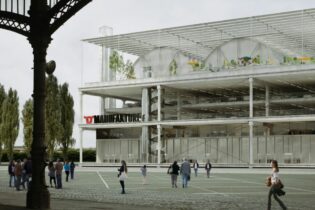‘the Felix’ municipal building
Gentbrugge, Belgium, Europe
| Total technical installations cost: | +/- € 5.100.000,00 excl. VAT |
| Total construction cost: | +/- € 14.200.000,00 excl. VAT |
| E Level: | 55 (ABC) / 49 (D) |
Project description:
The existing service centre of Gentbrugge is undergoing a complete renovation and transformation. The Building will be called ‘the Felix’ – a reference to the original architect Paul Felix – and will house the art academy ‘De Kunstbrug’, a primary school, a community library with a reading café, a municipal office and a police station, among other things.
The building, situated on the outskirts of the nature reserve ‘de Gentbrugse Meersen’, dates from the 1970s and was already subject to a first limited renovation. For buildings like this – just not unique enough to be protected, with an obstinate concrete architecture that scores poorly on all sorts of energy criteria – demolition is often undertaken without a thorough analysis. Our design goes completely against this pattern and proposes maximum reuse, taking into account the high demands of, for example, the music academy or the police station.
The design for the transformation proposes interventions that convert the character of the site from an administrative building to an all-round urban building where encounters between different users are the focus. The 3 existing buildings are complemented by an extension – dance hall, office space, and rooftop playground. Felix’s plan to have flowers and plants grow on the deep balconies is resumed. The library forms the hub of the ground floor and is surrounded by open working spaces that reinforce the contact between different users. A fourth building – the theatre – is added, creating an inner courtyard with the adjacent buildings.
A thoughtful design of the building complex and its envelope can reduce the heating and cooling requirements. This allows technical installations to be kept to a minimum. Sustainability is implemented in a broad sense and includes various aspects such as energy generation, heat recovery, reduction of losses, water (re)use, optimisation of artificial and daylight and the measurement and dynamic adjustment of energy, air and water flows.
Water-water heat pumps connected to the BTES field (geo-thermal drilling) are responsible for the production of hot water for heating; if the balance is disturbed too much, a Drycooler can be used to keep the ground in balance over the longer term.
The output elements for heating and/or cooling vary according to the function of the building and room:
o Convectors with thermostatic valve system for basic heating.
o Cooling ceilings and/or ventilo-convectors with local control and sensor for spaces to be heated and/or cooled.
o Underfloor heating with internal sensor for basic heating of large rooms that need to be heated almost continuously.
o Large spaces such as dance halls, multipurpose concert hall and refectory where large air volumes are already present, are conditioned all-air.
No gas connection is provided on site.
A type D ventilation system with continuous heat recovery (by means of a heat wheel or plate exchanger, demand-controlled) ensures a healthy and pleasant indoor climate in all blocks.
Another cost-saving and sustainable measure is good water management, including the use of rainwater and rainwater recovery for the sanitary cells and for double service taps. Water is a precious commodity, so it is best to use it as sparingly as possible. Water-saving taps are therefore not a luxury but a must.
Finally, the buildings must be equipped with natural and artificial ambient lighting that is pleasant to the eyes and illuminates the room adequately. In general, LED lighting is used, but in order to keep energy consumption costs as low as possible, absence detection is provided for offices and meeting rooms, central on/off for large spaces and movement detection in sanitary facilities and storage rooms.
An additional sustainable feature is that a proportion of the electricity consumed is generated locally. Where possible, photovoltaic panels will be installed over the entire roof area.
The site houses various buildings with different functions and users. All are linked to a central generator so that the synergy between these buildings can be optimally used. When the cooling season starts in the office building, heating is still needed in the classrooms. As a result, this heat can be exchanged directly with each other. Applying such synergy requires a good building management system.
As already mentioned, a well thought-out design of the technical installations offers several advantages. Just think of the maintenance of the installation. For example: maintenance of the installation. An installation that is easy to maintain will always result in an installation that is actually well maintained.
Also in the choice of technical components, standardisation throughout the building is always opted for. By using standard components, parts can easily be replaced by the supplier without the client having to build up a large stock. The number of types of lighting fixtures, for example, is also limited so that replacement can easily take place with devices from within the building.
The technical installation is clearly structured making it easy to read and the service technician quickly understands the entire installation. For example, the air groups for various building sections have been placed close to their respective sections. This limits the number of channel lengths and ensures that the installation remains easy for the maintenance company to handle. If certain sections are not used, it is easy to shut down the relevant groups (e.g. weekend mode for office sections where police or classrooms still need to be operated).
The next step in the process is to ensure that the components are always easily accessible. In this case, the main components were placed in the technical rooms early on in the design process to ensure that the rooms were sufficiently large. For example, the maintenance area surrounding the equipment was always taken into account as required by the manufacturer. It is also important to ensure that the various components are properly controlled. Poor control will usually result in premature wear and tear, e.g. the number of start/stop cycles of a heat pump.
A final step is to incorporate a certain redundancy in case of a defect, allowing another device to take over fully or partially. In this design, we always provide for a deduplication of the heat pump so that at least 50% of the power remains available if one machine fails.




















